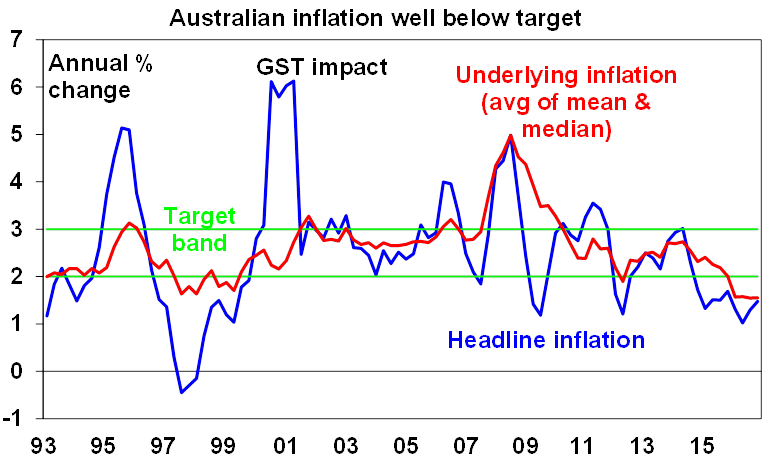Nothing for markets to worry about in the Consumer Price Index for the December quarter.
It’s the one statistic this month that could have had an immediate impact on market and Reserve Bank thinking about the economy.
And the bottom line is no impact whatsoever with inflation remaining subdued in the December quarter.
And even if it perks up in the current quarter because of the jump in oil and petrol prices in January that will be welcomed by the RBA which is looking for some stirring in inflationary pressures this year to boost incomes and nominal economic growth.
The March quarter usually sees a perking up of inflation because of all the increases in government charges and fees at the start of the year.
But the December quarter and any prospective growth in prices in the three months to March won’t produce any change to the no rate move approach of the RBA for all of this year. There is just no dangers to the economy from inflation.
The only reason rates might change (a cut) is if the global economy slows dramatically as investors and consumers take fright at the policies of Donald Trump.
The AMP’s chief economist, Dr Shane Oliver wrote in a note:
"Annual inflation at 1.5% in the December quarter is line with the RBA’s own forecasts, but record low wages growth and spare capacity in the economy (with GDP growth now running well below average) mean that underlying inflation is likely to take longer than the RBA is allowing to get back to its 2-3% inflation target band."
“We expect that continued weak inflationary pressures along with a downwards revision to the RBA’s growth forecasts following last September quarter’s contraction in GDP will force the RBA to cut the cash rate again by 0.25% taking it to 1.25%.
"A February rate cut looks unlikely at this stage – the labour market is holding up and the RBA may want to monitor the recent uptick in investor loan growth because of the risk to financial stability. But we think a rate cut is likely in May, following the next set of inflation data.”

Source: ABS, AMP Capital
The Australian inflation rate was 1.5% over 2016 with the Bureau of Statistics reporting that CPI rising a seasonally adjusted 0.5% in the December quarter, which was below market expectations.
The RBA’s closely-watched core inflation figure, which is inflation with volatile items stripped out, was 1.55% for the year, and 0.4% for the quarter.
Economists had expected an 0.7% inflation figure for the quarter, taking yearly headline inflation rate to 1.6%.
Inflation has lagged below the Reserve Bank of Australia’s 2-3% target band since late 2014. It bottomed at an annual 1% in the June quarter of last year
The most significant price rises this quarter are tobacco (+7.4%), automotive fuel (+6.7%) and restaurant meals (+1.1%). These rises are partially offset by falls in furnishings, household equipment and services (-0.8%) and communication (-0.8%).
The ABS said that vegetables rose 2.5% in the December quarter 2016. "Adverse weather conditions in major growing areas over previous periods continue to impact supply for particular vegetables (potatoes, capsicums, broccoli and cauliflower). Offsetting these rises are price falls for salad vegetables, tomatoes, lettuce and celery,” the Bureau noted.
Vegetable prices have risen 12.5% through the year to December quarter 2016.
So bottom line, no impact on monetary policy ahead of the RBA’s first meeting of the year on February 10.













